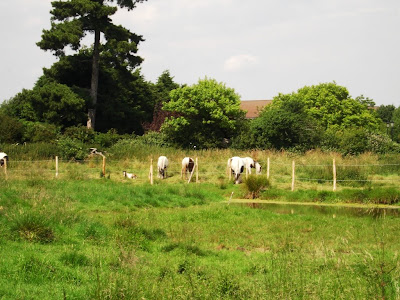The Chelmer in a sleepy mood on a hot sunny afternoon, insect life quietly vibrating in the still air. Butterflies feed on the thistle flowers, iridiscent demoiselles jet round the water in pairs, their furry wings reminding you of thick eyelashes. Clear blue damselflies are also to be seen, slender as matchsticks but just as beautiful.
Green lily pads lie on the surface of the water, some still submerged below in the clear water, the small yellow flower stands proudly above the water, this is not the slightly exotic nymphae white water lily but a lesser cousin, shoals of little fish, minnows or sticklebacks? swim in co-ordinated balletic movement breaking the surface of the water as they flash to and fro. A large perch skulks under the trailing tresses of the willow, slowly he emerges tail powering him through the rushes then back again to the shelter of the bank.
A froth of meadowsweet, faintly scented, hugs the water edge and the pink mallow with its darker veins intermingles with the meadowsweet and tangle of grasses.
All around the sap of life is strong, two dabchicks sit on a green crust of algae, whilst their mother swims round protectively. One performs the miracle of walking on water, his solemn stance caught on camera.
Down the path to the water meadow, the gypsy horses have been fenced away from the leat that runs to the mill. Mostly they are piebald, or 'painted' horses, the foals lie in the long grass and their mothers stand protectively over them. There is nothing quite like horses in summer to express the bounty of nature, their bellies are rounded and sleek from the rich grasses they munch on so reflectively, they exude a feeling of wellbeing and tranquillity, their coats softly shining in the sun.
Later on in the afternoon thunderstorms break up the heat of the day, louring dark skies, the crack and rumble of the thunder and quick sparks of the lightening, nature has decided to put on another show; the river must be exploding in showers of raindrops sparkling and dancing on the water but we are not there to see it....
Buddha fields; A term found in Gary Snyder's 'The Practice of the Wild' and a concept that has been going round in my mind for a couple of days, but the above walk can be viewed through this fine lense; so what is he talking, lets quote to start with;
"To show how totally and uniquely at home each life form must be in its own unique 'buddha-field. " Snyder takes his writing from an early 13th century sutra written by Dorgen Kigen, simply Mountains and Waters Sutra. So we can view through this same prism the insects and plant life by this quiet Essex river, its there but first you must understand and remove from your mind the western rational thought that forms and creates eco-systems of the world around you. True everything in life depends on something else for its food and existence but at the same time it is entire unto itself. Each creature lives in its own perfect circular world, the little circles of other lives overlap, the cycles of food and warmth brought on by a revolving world also plays a part. We see things as species, related to each other forming families of evolutionary criteria, and this may be so, but each life cycle knows nothing of this, only its own particular niche.
Here Synder describes a buddha field in a poem about Dall sheep..
.......cloud tatters, lavender artic light
on sedate wild sheep grazing
tundra greens, held in the web of clan,
and kin by bleats and smells to te slow
rotation of their Order living
half in the sky- damp wind up from the
whole North Slope and a taste of the icepack,
the primus roaring now,
here, have some tea....
These sheeps "playing, napping, eating, butting, circling, sitting, dozing in their high smoothed out beds on ledges at the cliff edge of life and death". Are our horses in the field completely at home in the sun with their young there is no past and present just the now of being.

Beautiful photographs and a lovely, lyrical piece of writing. Those scenes are absolutely timeless, it must have looked just like that 100 years ago and further back than that too.
ReplyDeleteThanks for that Rowan, think the wild flowers manage to hold on because there are no (sprayed) fields around..
ReplyDeleteThelma
Lovely piece of writing and photographs. Frankie x
ReplyDelete